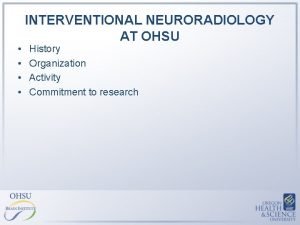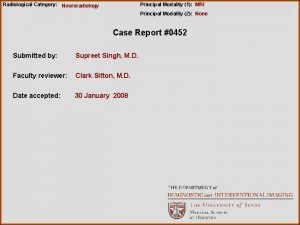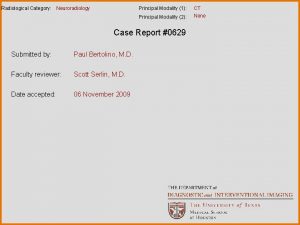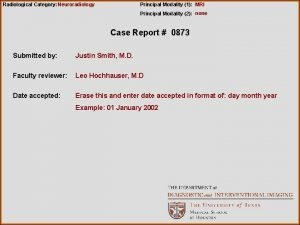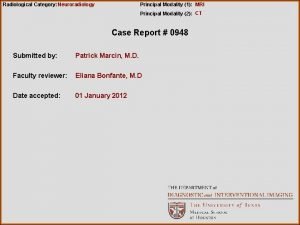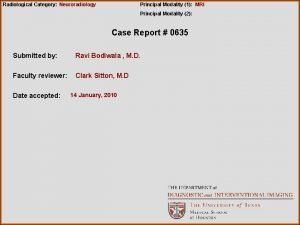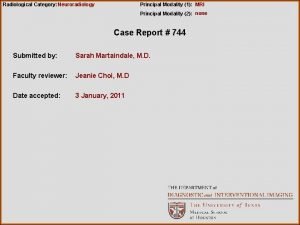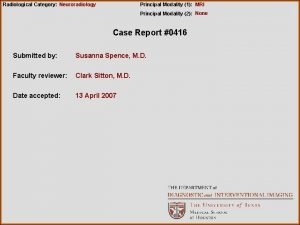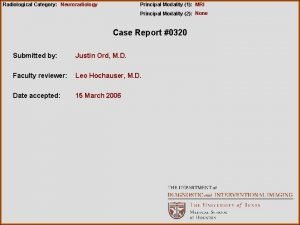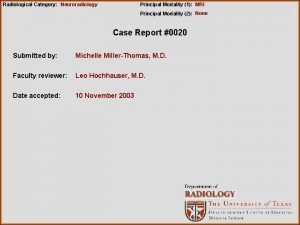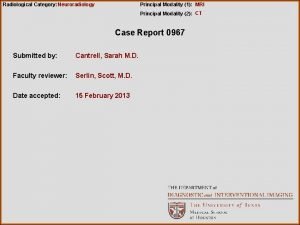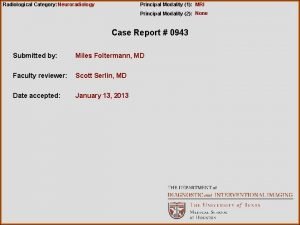Radiological Category Neuroradiology Principal Modality 1 MRI Case













- Slides: 13

Radiological Category: Neuroradiology Principal Modality (1): MRI Case Report #0014 Submitted by: Faculty reviewer: Date accepted: Casey Fatz, M. D. Norman E. Leeds, M. D. 29 May 2003

Case History 45 year old female patient with hemiparesis.

Radiological Presentations DWI b=500 A DWI b=1000 B ADC map C

Radiological Presentations FLAIR T 2 T 1 D E F

Test Your Diagnosis Which one of the following is your choice for the appropriate diagnosis? After your selection, go to next page. 1. 2. 3. 4. Acute infarct with diffusion restriction. Subacute infarct with vasogenic edema and T 2 shine through. Chronic infarction Focal encephalitis.

Findings and Differentials Findings: 72 yr old patient who had left MCA posterior branch infarction. A, B) MRI DWI (b=500, 1000) demonstrates increased SI in the left MCA territory on b=500 DWI while normal SI on b=1000 DWI related to T 2 shine through effect that is more prominent on low gradient strength. C) ADC map (b=1000) demonstrates increased intensity due to increased diffusion excluding the presence of any diffusion restriction. This increased diffusion is due to vasogenic edema in the subacute stage of infarction. D, E) MRI FLAIR and T 2 WI demonstrate bright signal from vasogenic edema. F) MRI T 1 WI demonstrates early gliosis (cortical laminar necrosis).

Histopathologic changes in infarction MO Fibrosis (Gliosis) PMNs MO Initial reversible cytotoxic edema Irreversible cytotoxic edema intermixed with interstitial edema Late interstitial edema with gliosis

Normal Brownian random water motion in normal state Normal cell Water molecule Swollen cell Restricted motion of water molecules due to cellular swelling and contraction of the interstitial compartment.

Cytotoxic and interstitial edema Cytotoxic edema Interstitial (vasogenic) edema Acute vascular occlusion Brief period immediately following vascular insult (ictus) The cells are normal. Reversible stage of cytotoxic edema. Na+/K+ ATPase pump is dysfunctional, but the cellular organelles are not damaged yet. Irreversible cytotoxic edema following lethal hit to the cellular energy production organelles. Ictus Interstitial (vasogenic) edema. Cytotoxic edema 0 30 min First few hours Time Interstitial edema and gliosis Interstitial edema 10 days

Diffusion Weighted MRI and Conventional MRI prediction of histopathologic changes • DWI (Diffusion Weighted Imaging) and ADC (Apparent Diffusion Coefficient) MRI sequences are very sensitive to diffusion restriction and cytotoxic edema. • Diffusion restriction is bright on DWI and dark on ADC map. • DWI signal intensity is calculated from the following formula: SI DWI = SI T 2 x exp ( -b x ADC ) b value is directly related to the gradient strength (magnet strength). The higher the b value, the stronger the DWI signal. SI DWI : Signal intensity on DWI SI T 2 : Signal intensity on T 2 b : Diffusion sensitivity Factor ADC : Apparent Diffusion Coefficient • This equation indicates that DWI signal has T 2 contrast as part of the total signal. • ADC map is a more accurate image to predict the diffusion restriction as it represents the distribution of ADC throughout the brain without the influence of T 2 signal

Evolution of cytotoxic edema and vasogenic edema in acute and subacute stroke. Ictus Cytotoxic edema 0 30 min First few hours Time 10 days

T 2 Shine Through DWI SI is influenced by T 2 signal as concluded from its SI formula while ADC map is a pure diffusion effect. SI DWI = SI T 2 x exp ( -b x ADC ) The DWI SI is influenced by the b value. The higher the b value, the stronger the diffusion SI and the lesser the influence from T 2 SI. References 1. 2. 3. Cotran: Robbins Pathologic Basis of Disease, Chapter one, CELL INJURY AND NECROSIS. 6 th ed 1999 W. B. Saunders Company. Maarten G. Lansberg, Vincent N. Thijs, Michael W. O'Brien, Juan O. Ali, Alex J. de Crespigny, David C. Tong, Michael E. Moseley, and Gregory W. Albers. Evolution of Apparent Diffusion Coefficient, Diffusion-weighted, and T 2 -weighted Signal Intensity of Acute Stroke. AJNR Am J Neuroradiol 2001 22: 637 -644. Mark C. De. Lano, Thomas G. Cooper, James E. Siebert, Michael J. Potchen, and Karthik Kuppusamy. High-b-value Diffusionweighted MR Imaging of Adult Brain: Image Contrast and Apparent Diffusion Coefficient Map Features. AJNR Am J Neuroradiol 2000 21: 1830 -1836.

Diagnosis Subacute cerebral infarction with vasogenic edema and T 2 shine through phenomena
 Ohsu neuroradiology
Ohsu neuroradiology Erate pa
Erate pa Tennessee division of radiological health
Tennessee division of radiological health Center for devices and radiological health
Center for devices and radiological health National radiological emergency preparedness conference
National radiological emergency preparedness conference Radiological dispersal device
Radiological dispersal device Mri principal
Mri principal Best worst and average case
Best worst and average case Reelsogramm
Reelsogramm Modality
Modality Skill focus: persuasion
Skill focus: persuasion Pacs modality workstation
Pacs modality workstation Diplode
Diplode Tom arbuthnot
Tom arbuthnot
